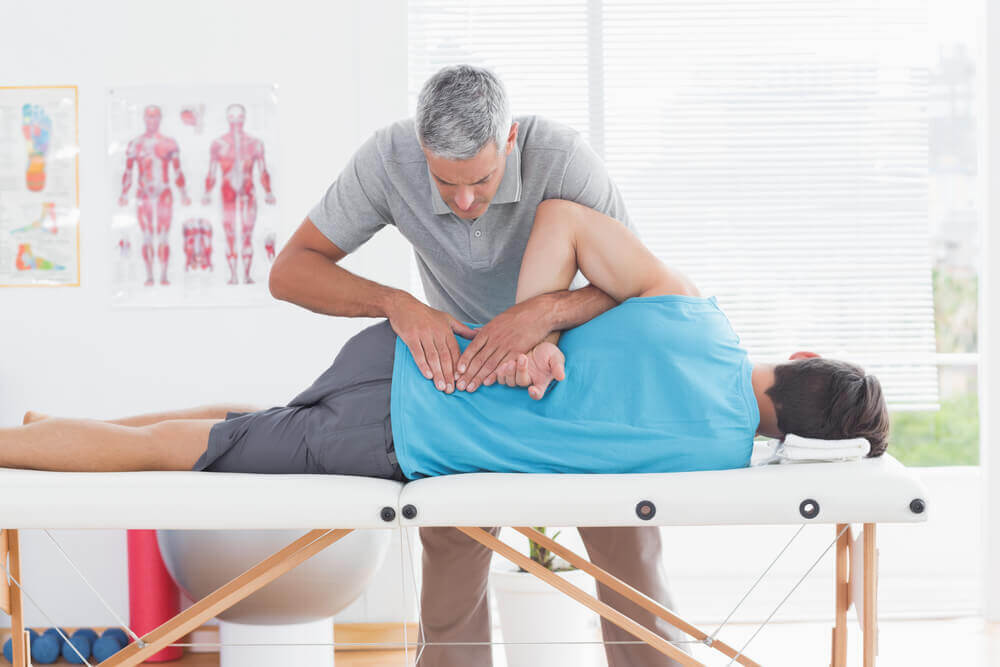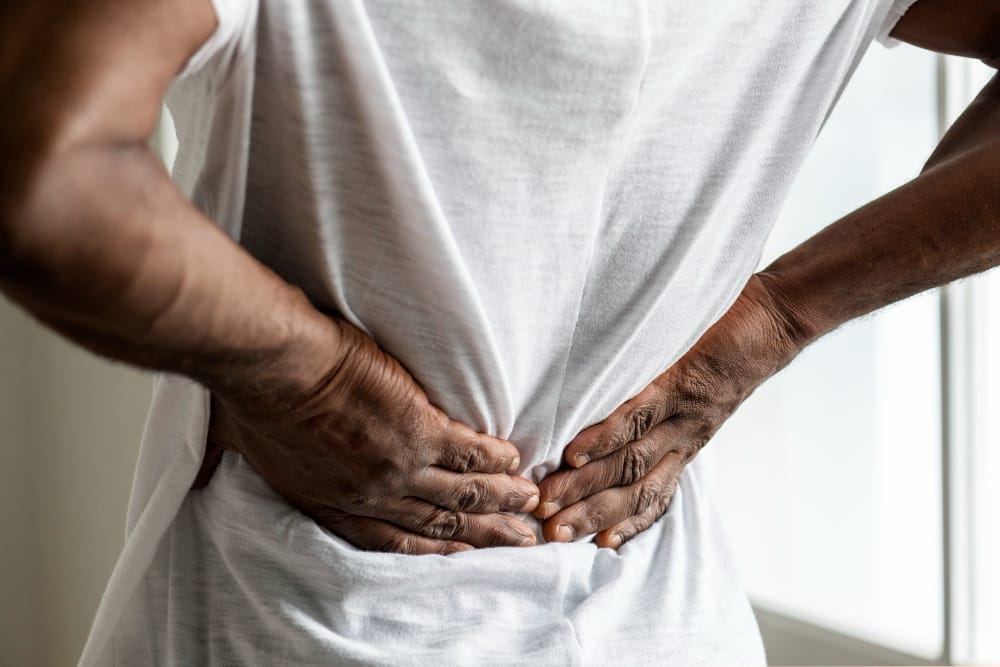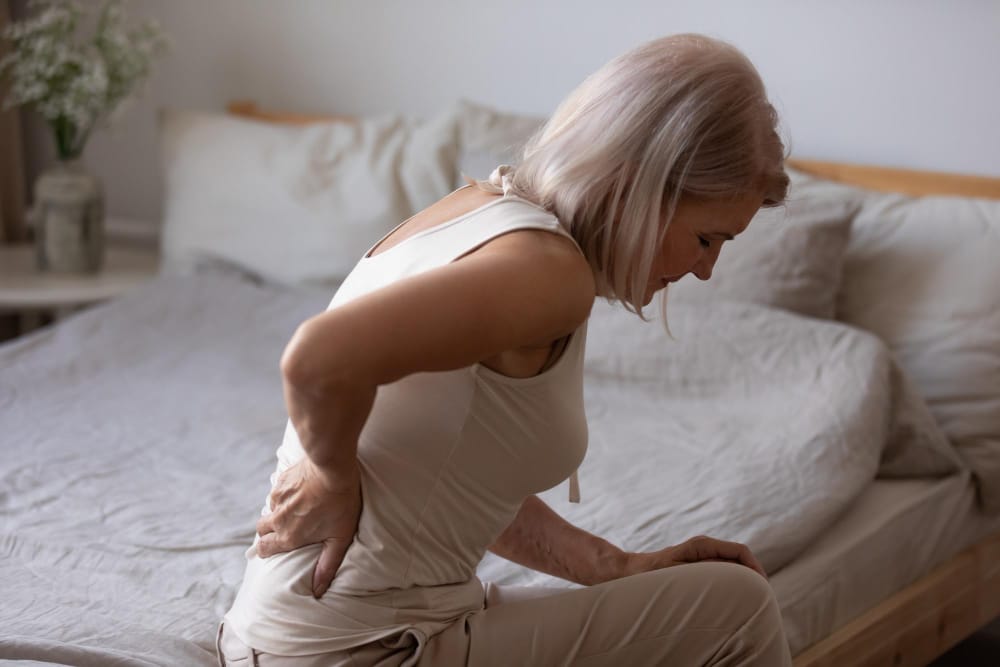
Back pain can be the result of conditions relating to the joints, bones, muscles, nerves, or connective tissues. The back is a complex system providing support to the entire body. The spine provides the back with structure and is made up of a column of vertebrae.
According to the Australian Institute of Health and Welfare, chronic back problems affect 16% of Australians and contribute to 28% of those with a disability. Chronic back issues can significantly lower a person’s quality of life, which affects their ability to participate in work, social activities, and daily activities. Here’s a breakdown of different types of back pain, their causes, symptoms, and treatment options.
- Muscle Strains and Ligament Sprains
- Arthritis, Osteoarthritis, Spinal stenosis
- Osteoporosis
- Sciatica
- Stress
- Postural Pain
- Diet, Obesity
Back Muscle Strains And Ligaments Sprains

Around 70% of back pain is caused by muscle strain or muscle overactivity and spasm. A strain is an injury to the muscle or tendon. The tendons are strong, fibrous bands that connect the muscles to the bones. A back strain may occur when the muscles and tendons supporting the spine are pulled, overstretched, or twisted. Typical causes are overuse, stress, and lifting heavy objects that your body is not conditioned for.
Sprains usually occur after a sudden fall or twist where a ligament is overstretched. Strains occur when the body is overloaded and the muscle spasms. People who play a sport that involves pushing and pulling movements are at higher risk, as are people who routinely overload their back or are overweight.
Symptoms Of Muscle Strains And Ligament Sprains
Sprains and strains in the back region usually result in aches, spasms, pain, and difficulty bending over. Depending on the severity, it can be hard to stand up straight or move around.
Treating Muscle Strains And Ligament Sprains
Some sprains and strains in the lumbar region will heal on their own without any problems within a few weeks. Immediate treatment for a back injury will usually involve heat as most back injuries involve muscular tension. If symptoms persist, visiting a physiotherapist and seeking professional help is critical. If left unchecked, some injuries can worsen over time and develop into chronic conditions.
Arthritis: Back Pain Causes And Treatment
When it comes to back pain, Arthritis is a common issue affecting people’s bones. Of the 100 different types of arthritis, Osteoarthritis is the most common. Osteoarthritis in the spine is a breakdown of cartilage in the joints or discs in the lower back and neck. Spinal stenosis is another type of arthritis that causes the thickening of bones and ligaments in the spine. This compresses the spinal nerves causing lower back pain, numbness, and bowel problems.
Symptoms Of Arthritis
Pain and stiffness are the most common symptoms resulting from arthritis. Flexibility and movement can also be difficult, while swelling, numbness, and tenderness are also common features.
Treating Arthritis
Non-surgical treatments will depend on age, condition, and other factors. They usually involve medications targeting inflammation and physical therapy to regain range of motion and flexibility. Changes to diet and lifestyle are also worthwhile treatments. In severe cases, surgery may be necessary to fix nerve roots or stabilise the spine.
Back Pain Causes And Treatment: Osteoporosis

Osteoporosis is a common condition that affects over 1 million Australians. This disease causes the bones to become brittle and increases the risk of fractures. Osteoporosis occurs when the bones lose mineral density faster than it can be replaced. This results in a loss of overall bone quality and density. Osteoporosis in the spine can cause vertebral fractures or compression fractures. Fractures in this area can cause persistent sharp pain and limited movement. If several fractures occur there can be a significant change in the curve of the spine.
Symptoms Of Osteoporosis
Common symptoms include back pain, loss of height, postural dysfunction, and bones breaking more frequently. In the earlier stages, osteoporosis can be recognised by a weaker grip and increasingly brittle fingernails.
Treating Back Pain Caused By Osteoporosis
Most treatments are aimed at increasing nutrition and vitamin C intake. Increasing calcium and staying active will boost bone health over the long term. Medications are also common in the fight against more severe cases and a combination of this and broader lifestyle changes are the most effective. It is also important to get involved in a strength training program specific to osteoporosis. Your physiotherapist for back pain can guide you on this to ensure it is right for you.
How Sciatica Causes Back Pain
Sciatica is caused by irritation or compression of the sciatic nerve resulting in discomfort, pain, or numbness in the back or leg. The sciatic nerve is a large nerve that begins in the spinal cord. Its roots pass between the disc spaces and travel from the spine to the buttocks and into the leg. This nerve controls the function and delivers sensation to the leg and foot.
Symptoms Of Sciatica
Sciatica or sciatic-like symptoms can be caused by disc protrusion (part of the disc material pushing onto the nerve) or more commonly a swelling in the region of the disc. This results in pain extending from your lower back down to the legs and calf. Pain can range from a mild ache to sharp, sometimes excruciating spasms. Sciatic like symptoms can also be caused by other problems such as gluteal pain, piriformis syndrome and sacroiliac joint dysfunction.
How To Treat Sciatica
Physiotherapy is excellent for rehabilitation, regaining full movement, and restoring function. Surgery is only reserved for severe cases where the nerve is impinged and the muscles are becoming too weak to function. Surgery also becomes more relevant when conservative management has failed.
How Stress Affects Back Pain, Causes And Treatment

Back pain is also caused by constant stress and postural control. Many of the more serious back pain problems are a result of underlying behavioural and lifestyle choices that over a lifetime compound into chronic pain. Studies show that there is a direct link between deconditioning, postural dysfunction and back pain. Computer use, watching television, and playing video games in high volume will lead to deconditioning and places individuals at higher risk of chronic pain disorders. People who spend a lot of time in a slumped sitting position are 50% more likely to suffer from chronic lower back pain.
Symptoms Of Stress-Related Back Pain
Tighter back muscles, stiffness, and irritability are all common symptoms of stress-related conditions. Consistent stress can be detrimental to both mental health and physical wellbeing. Stress often precipitates pain, which, in turn, affects mood and activity levels. This may impact everyday life and reduce movement, causing the muscles to weaken and tighten further, resulting in more pain.
Back Pain Treatment: Minimising Stress
Minimising stress through relaxation techniques such as exercise, meditation, and yoga can greatly reduce pain and ease chronic conditions. Physical activities release endorphins that lower stress levels throughout your body.
Back Pain Causes And Treatment: Obesity
Diet plays a huge role in back health. From bone health to nutrient intake, vitamin levels, stress levels, and weight, food is important when it comes to staying pain-free. People who are overweight or obese generally have a higher risk of suffering from back pain, spinal problems, or joint and muscle issues. Weight in the abdominal region pulls the pelvis forward placing additional strain on the spine and straining the lower back.
Symptoms Of Obesity-Caused Back Pain
Not only does excess weight cause pain in the lower back from spinal strain, but it also exacerbates existing conditions such as bad posture or spine osteoarthritis. Common back-related symptoms that arise from obesity are pain, fatigue, muscle spasms, and weakness.
Treating Obesity And Back Pain
Significant lifestyle changes are often necessary to overcome obesity and reduce lower back pain. Losing weight will relieve the strain on the spine caused by the excess weight. The correct diet will be the first step in the process. Even when obesity isn’t the main cause of back pain, a healthy weight will improve the efficacy of other treatments.
Get The Right Help
As challenging as it may seem, getting the right help to overcome back pain is a crucial first step. Consulting a Physiotherapist in Perth will get you on track with the right exercises, habits, and programs to reduce pain. Back Pain, its causes, and treatment options can be managed and with the right program, it can become a thing of the past.





